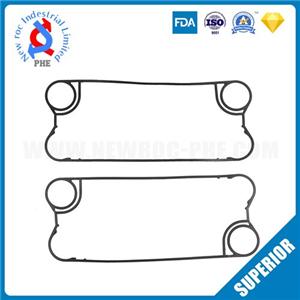Introduction of marine plate heat exchanger
In marine turbines, heat exchange is undoubtedly a very critical factor to ensure the normal use of the engine. Because when the turbine is working, it needs to maintain a certain temperature to ensure the normal operation of the machine. There are many types of heat exchangers used in marine engines, and the plate heat exchanger is one of the most important heat exchangers, and will become a very popular potential equipment on ships in the future.
The heat exchanger is one of the indispensable equipment for marine engines, which can be applied to main and auxiliary oil coolers, liner fresh water coolers, fuel heaters, steam condensers, water heaters and other equipment. The special working environment of ships has very special requirements for heat exchangers, including factors such as ocean instability, which may encounter vibration, shock, large-angle tilt and noise. The cooling medium is usually sea water with high salt concentration, high humidity in the working environment, and strong corrosiveness of the board. The ocean itself has a very compact structure, which has stricter restrictions on the space and quality of the heat exchanger. The heat transfer medium of traditional heat exchangers is always water, and the heat transfer medium of marine heat exchangers is generally oil and water. The emergence of plate heat exchangers effectively solved a large part of the problem.
1. Ship equipment has compact structure and low quality.
Currently, plate heat exchangers used in marine turbines are generally considered to be smaller than traditional heat exchangers and have a very small volume. For this, finite element analysis is used. At the same time, in order to meet the requirements of marine equipment, unnecessary parts of the plate are removed or reduced according to the actual stress and strain distribution, and the weak parts are locally thickened. The gas cutting method is placed on the whole body to reduce the influence of welding deformation on the strength, and the inner plate and the face plate are welded together to eliminate residual stress. It will be able to use the equipment as much as possible in a limited space and bring more benefits; it will complete the heat transfer work to ensure the normal use of the ocean.
2. Ship equipment must have impact, large-angle shaking, vibration and other issues.
A multi-point fixing method is adopted at the bottom of the circuit board, that is, all fixed parts can be fixedly connected. Some important special parts also use rib structure, which increases the stability of the equipment. Only by improving the installation stability can the heat exchange efficiency and the effect of the heat exchanger be ensured. Once it occurs due to problems such as vibration, it will affect the heat transfer effect,
3. The cooling medium is the problem of high concentration of sea water and nitrogen ions
Since many turbines are in direct contact with seawater, they have a very large impact on the heat transfer medium during use. Therefore, currently, plates used in turbines are usually made of materials with high corrosion resistance, such as titanium materials, and their quality is much smaller than that of stainless steel. In order to ensure the quality of the titanium plates, in addition to regular inspections, a 100% color penetration test is also performed on the plates to further eliminate errors in the plate sampling.
4. Heat transfer medium problem
Because the difference in specific heat capacity between water and oil is relatively large, the temperature difference in the heat transfer process is relatively large, and the heat transfer coefficient is also relatively large. In order to make the product reliable and economical, it is necessary to ensure the oil-water heat transfer performance under the working conditions of the ship to ensure that the equipment has a certain heat exchange margin. Only when the heat medium can effectively conduct heat can the heat transfer effect be achieved.
5. Low price and operability
The plate heat exchanger is inexpensive and the production process is very mature. In the production or maintenance process, we can reduce costs and increase efficiency as much as possible. It can be cleaned by loosening the screws in the mounting structure, and then reassembled and used again. If it is damaged, then we can change to a new one. Its low price allows it to be prepared in emergency equipment.




